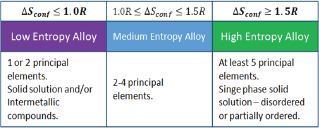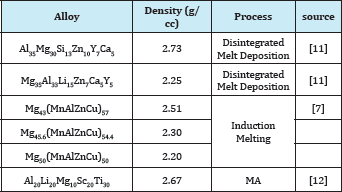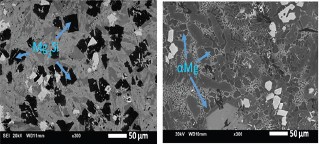- Submissions

Full Text
Research & Development in Material Science
An Insight into the Development of Light Weight High Entropy Alloys
Manoj Gupta* and Khin Sandar Tun
Department of Mechanical Engineering, National University of Singapore, Singapore
*Corresponding author: Manoj Gupta, Department of Mechanical Engineering, National University of Singapore, 9 Engineering Drive 1, Singapore 117576
Submission: October 31, 2017; Published: November 29, 2017

ISSN : 2576-8840Volume2 Issue2
Abstract
High Entropy Alloys (HEAs) have been emerged as conceptually innovative alloys that defied the conventional alloying concepts. The concept of HEAs is based on designing the alloys with multiple principal elements ranging from 5 to 35 atomic percent with a target to form single phase solid solution arising from high entropy of the system. The initial development of HEAs was based on the high density principal elements. Recently, low density elements such as Mg, Al, Li, Si and Ca were used to develop light weight high entropy alloy (LWHEA) systems to address the issues related to greenhouse gas emissions. LWHEAs with equiatomic and non-equiatomic compositions were developed successfully. However, single phase solid solution was seldom formed in LWHEAs. In view of current development on LWHEAs, chemical compositions, microstructure and mechanical properties are reviewed and presented in this study.
Current Development of LWHEAs
Figure 1: Basic differences in low, medium and high entropy alloys.

Evolution of materials is synonymous with the evolution of human civilization from time immemorial. Discovery and development of key materials such as gold, silver, copper, iron, aluminum, silicon, superconductors, and electronic materials has each played a crucial role in ensuring a better life for humans. The discovery and application of alloying and composite technology further diversified the range of properties that can be realized from different categories of materials specially the metals. In pursuit to discover new materials with enhanced properties, a recent advancement that has captured the attention of researchers worldwide is the discovery of High Entropy Alloys (HEAs) [1,2]. HEAs are based on a minimum of 5 principal elements unlike the conventional alloys where there is mostly 1 principal element. Five or more elements in HEAs are normally integrated in equiatomic proportion while there are also attempts made on non-equiatomic proportions as well [1,2]. HEAs exhibit a configurational entropy that is>1.5R (R is gas constant) and as a consequence exhibit a simplified solid solution microstructure rather than characterized by presence of intermetallic compounds (Figure 1).
Initial work on development of HEAs used principal elements with relatively high density such as Hf, Ti, V, Ta, Nb, Zr etc [3-6]. Promising properties were reported including superior hardness, wear, oxidation and corrosion resistance. The density values of most of the HEAs initially developed ranged from ~3g/cc [7] to 11.49g/cc [3].
In order to preserve and enhance the quality of environment and human health, researchers are currently focussing on sustainable technologies that do not pollute land, air and water thus leading to an ecosystem that is preferably superior to what we are living in. One of the major issue faced by humanity is global warming. Global warming arises principally from the burning of fossil fuels that releases greenhouse gases such as carbon dioxide and transportation sector is one of the main culprit. Global warming is near its tipping point and the clmate change will be irreversible if the temperature rises to 2 °C beyond that of pre-industrial time [8]. One of the methods to arrest and reduce the emissions of green house gases is by reducing the weight of vehicles/automobiles. For example, every 10kg weight reduction of vehicle translates into 1.25g/km carbon dioxide reduction [9]. Among the different metallic materialsaluminum with a density of 2.7g/cc dominates currently as light weight material in automobile, sports, aerospace, electronics and space sectors. Magnesium with a density of 1.74g/ cc is the relatively new entry in recent years triggered by the discovery of huge reserves both in land and water bodies [10]. With a potential of ~33% additional weight saving over aluminum, magnesium is currently the cynosure for materials developers. Besides, magnesium is a nutritional element required by human body and plants for healthy growth unlike aluminum which is widely established as neurotoxic element. Accordingly, recycling of magnesium is not an issue and its entry into food chain will only be beneficial. Thus magnesium has dual advantages of being lightweight and a nutritional element.
In view ofthe key advantages of magnesium, researchers are also attempting to develop HEAs by integrating light weight elements for providing alternatives to materials selectors for weight critical applications. Some of these light weight elements that can lead to low density HEAs are Mg, Li, Al, Si, Ca and Sc. They are often present in dominance in light weight HEAs (LWHEAs) which can be defined as one with overall density<3g/cc and preferably below the density of aluminum (2.7g/cc). A list of some LWHEAs reported in public domain are listed in Table 1 along with their processsing routes.
Table 1: List of LWHEAs and their processing routes.

Figure 2: SEM micrographs of light weight high entropy alloys: a) Al35Mg30Si13Zn10Y7Ca5 alloy (406±15HV) and b) Mg35Al33Li15Zn7Ca5Y5 alloy (237±10HV).

Table 1 indicates that both liquid and solid pahse routes are successfully employed to synthesize LWHEAs. To note is that many of these LWHEAs are not equiatomic and often shows the presence of secondary phases [7,11] (Figure 2).Comparison with a commercial AZ31 Mg alloy shows that LWHEAs hardness values are almost 3-6 times higher [13].
Hardness and compressive properties are commonly reported for HEAs in general. In general, HEAs including LWHEAs reveal high hardness values attributed primarily to solid solution and precipitation effects. Table 2 shows hardness values of LWHEAs reported in literature.
Table 2: Microhardness of different LWHEAs.

Table 3: Compressiveproperties of LWHEAs.

The compressive properties of LWHEAs are shown in Table 3. The results revealed appreciable levels of yield and peak stress and failure strains limited to <5%. The relatively high yield stresses of LWHEAs compared to commercial AZ31 Mg alloy indicate difficulty in initiation of motion of dislocations due to inherent microstructural differences. The peak stress, however, was similar with lower strain values suggesting an early crack nucleation due the inability of dislocations to move beyond certain extent and accumulation of stress levels.
LWHEAs research work so far does not report tensile properties and the lowest density is 2.20. While the density levels less than that of currently used aluminum alloys alloys are realized they are still far away from that of magnesium alloys. There are many challenges faced in developing LWHEAs as most of the equiatomic compositions tried are very brittle or reactive with environment due to the selected number of elements that can be mixed maintaining the low density. It is hoped that dedicated research work will be conducted by research community to develop new LWHEAs that can be found suitable for wide spectrum of weight critical applications. The challenge stays.
Conclusion
Current research on LWHEAs development indicated that designing HEAs is still challenging as multiple phases appear in most of the alloy systems. Based on the reported data, LWHEAs revealed high hardness which is almost 3-6 times higher than that of conventional AZ31 alloy. Arising from the formation of multiple phases in LWHEAs, the compressive yield strength was relatively higher as compared to AZ31 alloy. However, the fracture strain was <5% showing limited plasticity. To date, the most crucial challenge in developing LWHEAs sets on the inevitable formation of secondary phases. Further research efforts are required to contain the types and amount of secondary phases through smart compositional control to realize a better combination of hardness, strength and plasticity.
Acknowledgement
The authors gratefully acknowledge Ministry of Education Academic Research Funding (WBS#R-265-000-586-114) for the financial support.
References
- Amit K, Gupta M (2016) An insight into evolution of light weight high entropy alloys: a review. Metals 6(9): 199.
- Wei Yeh J (2014) Recent progress in high-entropy alloys, Annales De Chimie-Science, des Materiaux, In: Murty BS, Yeh JW, Ranganathan S (Eds.), High-Entropy Alloys. (1st edn), 31(6): 633-648.
- Yang X, Zhang Y, Liaw P (2012) Microstructure and compressive properties of NbTiVTaAlx high entropy alloys. Procedia Engineering 36:292-298.
- Senkov O, Scott JM, Senkova SV, Miracle DB, Woodward CF (2011) Microstructure and room temperature properties of a high-entropy TaNbHfZrTi alloy. Journal of alloys and compounds 509(20): 6043-6048.
- Lilensten L, Couzinie, Perriere L, bourgon J, Emery N (2014) New structure in refractory high-entropy alloys. Materials Letters 132: 123125.
- Stepanov N (2015) Effect of Al on structure and mechanical properties of AlxNbTiVZr (x=0,0.5,1,1.5) high entropy alloys. Materials Science and Technology 31(10): 1184-1193.
- Li R, Gao JC, Fan K (2010) Study to microstructure and mechanical properties of Mg containing high entropy alloys. Materials Science Forum, Trans Tech Publ 650: 265-271.
- Kinver M (2016) Earth warming to climate tipping point, warns study. Science & Environment, BBC News.
- Elalem A, Bourawi MS (2010) Reduction of automobile carbon dioxide emissions. Int J Mat Form 3(1): 663-666.
- Gupta M, Nai S (2011) Magnesium, Magnesium alloys and magnesium composites, John Wiley, USA.
- Tun KS, Srivatsan TS, Kumar A, Gupta M (2017) Synthesis of light weight high entropy alloys: Characterization of microstructure and mechanical response. PFAM, Chonbuk National Univ, Jeonju, South Korea.
- Youssef KM (2015) A novel low-density, high-hardness, high-entropy alloy with close-packed single-phase nanocrystalline structures. Materials Research Letters 3(2): 95-99.
- Nguyen QB, Manoj G (2010) Improving compressive strength and oxidation resistance of AZ31B magnesium alloy by addition of Nano- Al2O3 Particulates and Ca. Journal of Composite Materials 44(7): 883896.
© 2017 Manoj Gupta, et al. This is an open access article distributed under the terms of the Creative Commons Attribution License , which permits unrestricted use, distribution, and build upon your work non-commercially.
 a Creative Commons Attribution 4.0 International License. Based on a work at www.crimsonpublishers.com.
Best viewed in
a Creative Commons Attribution 4.0 International License. Based on a work at www.crimsonpublishers.com.
Best viewed in 







.jpg)






























 Editorial Board Registrations
Editorial Board Registrations Submit your Article
Submit your Article Refer a Friend
Refer a Friend Advertise With Us
Advertise With Us
.jpg)






.jpg)














.bmp)
.jpg)
.png)
.jpg)










.jpg)






.png)

.png)



.png)






